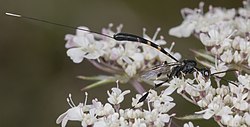Gasteruptiidae
| Gasteruptiidae | |
|---|---|

| |
| Gasteruption jaculator | |
| Scientific classification | |
| Kingdom: | |
| Phylum: | |
| Class: | |
| Order: | |
| Suborder: | |
| Superfamily: | |
| Family: | Gasteruptiidae
|

The Gasteruptiidae are one of the more distinctive families among the apocritan wasps, with surprisingly little variation in appearance for a group that contains around 500 species in two subfamilies (Gasteruptiinae and Hyptiogastrinae) and with 9 genera worldwide. The propleura form an elongated "neck", the petiole attaches very high on the propodeum, and the hind tibiae are swollen and club-like. The females commonly have long ovipositor (except in the genus Pseudofoenus), and lay eggs in the nests of solitary bees and wasps, where their larvae prey upon the host eggs, larvae and provisions.
The smaller of the two gasteruptiid subfamilies, Hyptiogastrinae, has a restricted Gondwanan distribution, with most species being found in Australia, and 2 species in New Zealand, 2 species in South America, and 8 species in the south-west Pacific (New Britain, New Caledonia, New Guinea, Fiji and Vanuatu).
The absence of "teeth" on the crown of the head and the somewhat thickened antennae readily separate these wasps from those in the unrelated family Stephanidae, which also contains very slender wasps with long necks.
External links
- Gasteruption sp. Diagnostic photos of male and female imagines.
- Gasteruptiidae Tree of Life, extensive article.
